Photographer Jose Cano and his wife, makeup artist Kungy Gay, turned to David Wallace of Arthouse Architects to create a family home above the sea on the outskirts of Nelson, New Zealand. The Kashiwa House was designed to be poetic, sustainable and respectful of the land on which it sits.
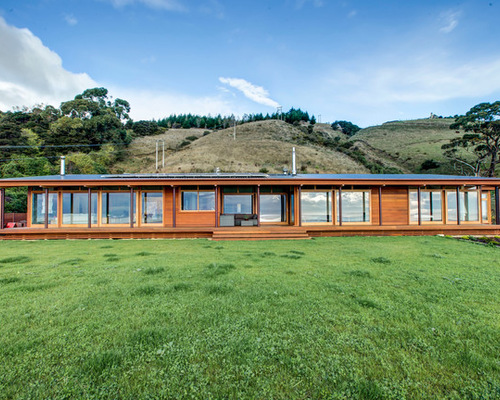

Arthouse Architects, original photo on Houzz
?
Houzz at a Glance
Who lives here: Jose Cano and Kungy Gay Cano and their teenage daughter
Location: Nelson, New Zealand
Size: 2,756 square feet (256 square meters); three bedrooms, two bathrooms
Architect: David Wallace of Arthouse Architects
Jose and Kungy are visually oriented people who create elaborately produced portraits of dancers and athletes in impossible poses that somehow look completely real. So it’s no surprise that they would be conceptual and precise with Wallace about the things that matter to them.
They wanted a human-scale, honest structure. They focused on sustainability, using wood, their favorite material, without constraining the architect with “this room must go here.” But the home did have to accommodate a studio for the pair’s business.
It helped that both architect and client loved the Japanese aesthetic (the Canos traveled extensively around Asia when they were living in Thailand for a decade, and fell in love with Japan) and that as artists they respected a fellow artist.
Wallace’s response was deceptively simple: The long, low house looks modest but is rich in detail.
Create a Comfy, Chic Book Nook
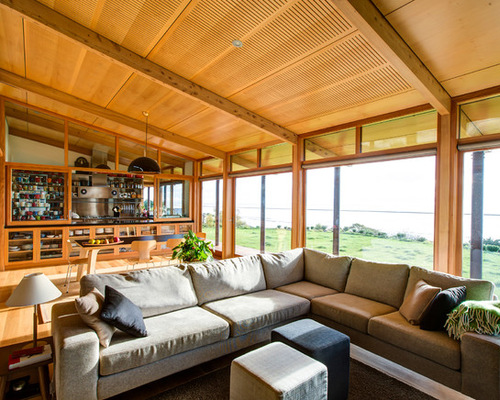

Arthouse Architects, original photo on Houzz
?
The site — sloping acreage overlooking Tasman Bay — wasn’t easy to find. Jose and Kungy were used to being near public transportation and close to town, but they also wanted space for their dogs and room for trees — Jose says he is obsessed with planting.
The site had been passed over by others because it had no road access, but Jose had built roads into hard-to-access forests, so he knew how to solve that problem. With Wallace, the couple chose a site that was tucked into the hill and protected from the wind, with views of the sea but not the road.
Wallace created a main north-facing wing to gather the sun and views, split by the entry porch, and an east-west wing that creates a sheltered courtyard. He anchored the entry with a spine of Waitaha stone from the nearby coast. Through the rest of the house he used a thoughtful palette of cedar for the exterior and millwork, European oak for the floors and birch ply for ceilings, highlighted by macrocarpa beams.
From the Japanese-style entry, sliding walls of glass open to a sheltered transition porch that frames views of Tasman Bay. To the left is Jose and Kungy’s studio. Windows to the kitchen, part of the main living wing, can be seen on the right. The birch-ply ceiling and cedar boards continue from inside to out, the spaces dissolving barriers.
Kiwi Beach Houses That Keep Things Simple
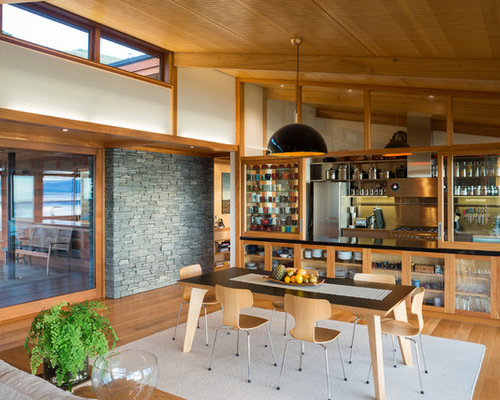

Arthouse Architects, original photo on Houzz
?
Bookshelves run the length of the hallway. The architect dropped the ceilings in the more intimate spaces to create a sense of warmth and enclosure
Wallace designed the house in repeating 8-foot sections separated by beams. This sets up a soothing rhythm that contributes to the serenity of the spaces. The raked ceiling meets clerestory windows to bring in northern light and vent heat in the summer.
The dropped ceiling on the right frames the view to the courtyard, and the stone fireplace wall in the back anchors the room.
The kitchen was one of the most important rooms for Jose and Kungy. They love their food and love to cook. But they didn’t want smells of spices and frying penetrating the rest of the house. Wallace’s solution was to frame the kitchen in glass, with sliding windows to open for serving and socializing. They can be closed while Jose and Kungy are working, allowing them to remain in view of their guests. The elegant cabinets are a modern glass twist on a Japanese tansu.
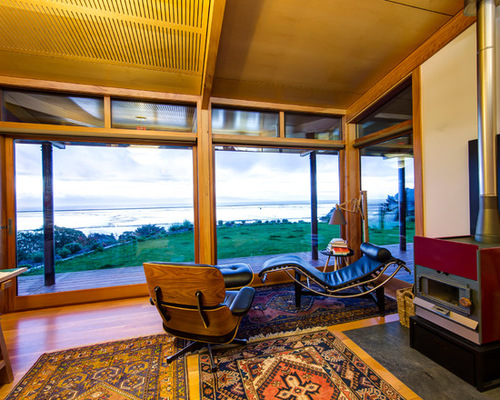

Arthouse Architects, original photo on Houzz
An industrial-strength exhaust fan and a commercial oven come in handy when Jose and Kungy cook their favorite cuisines. The Canos opted for commercial-kitchen-quality stainless steel counters and backsplash but continued the warmth of the birch ply in the cabinets.
Both client and architect sing the praises of Waimea West Joinery, which built the cabinets, shelves, windows and doors with real craft. The kitchen has become the couple’s favorite place for relaxing.
Off the main living wing is a wing of bedrooms (to the left of the picture, through the glass doors). It wraps around to protect the courtyard from the wind off the Tasman Bay and Tasman Sea, which can sometimes be fierce.
Although the courtyard is tucked between the wings of the house, the glass doors create a transparent edge, so people can still enjoy the sunsets. There is a small water feature for cooling sounds in the summer and raised beds for the family vegetable garden.
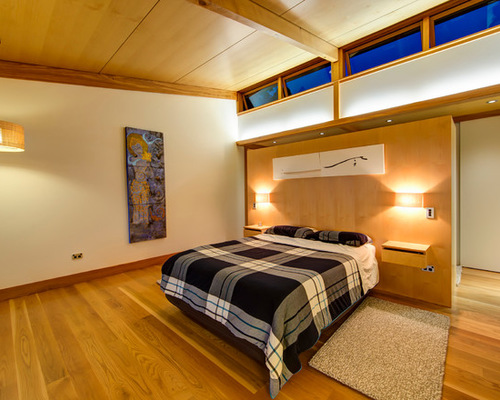

Arthouse Architects, original photo on Houzz
?
Jose and Kungy are delighted with the entire house, but when pressed, Jose says that the studio is his favorite spot. He likes to go there before dawn to read and watch the sun come up before the day of phone calls and running around takes over.
The New Zealand-designed Pyroclassic fireplace met the couple’s strict eco-criteria: It’s a clean-burning wood fireplace and is locally made. Jose planted dozens of trees on the property, and in a few years they should be ready for trimming to supply their firewood needs. The family has installed a second Pyroclassic in the living room because it’s so lovely and warm. In addition to passive solar heating and cooling, the house has photovoltaic cells for electricity and two large water tanks. The family has an electric car.
The utility room is beautifully crafted, with a balance of ply, cedar and stone.
Wallace designed the master bedroom to be a sanctuary. In addition to providing storage, the headboard “shelters” the bed from the closets to enhance the separation of the bedroom from busy household life.
With their love of Japan, it was no surprise that the couple wanted a bathroom that was as serene and contemplative as the rest of the house.
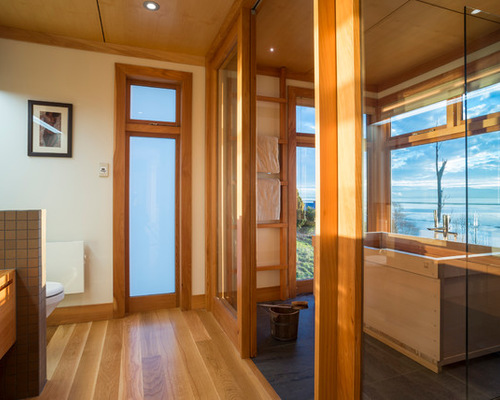

Arthouse Architects, original photo on Houzz
The Canos had imported the artisan-crafted tub from Japan for their previous house, and they brought it with them to the new house. With views across Tasman Bay, this is Jose and Kungy’s evening unwinding spot. They shower in the wet room (on the right edge of the photo), then relax and talk in the tub together as the sun goes down.
Many of the artisanal touches around the house were conceived among architect, client and woodworker. Jose particularly wanted round posts to hold up the porch roof. These are not available in the proportions Wallace designed, so they were custom turned from ancient jarrah imported from Australia. He designed the finely shaped rafters, and the steel bolts were highlighted in black, demonstrating the honest structure of the house.
The 8-foot modules were delineated on the deck too, with the subtle insertion of vertical boards. Wallace designed the overhang to shelter the house from harsh summer evening sun while still admitting the warming rays in the winter.
“David has these simply beautiful ideas. They’re so simple but so elegant,” Jose says. “It’s been a very nice process, like making music. All these things are repeated, like an elegantly written composition.”
Builder: Inch Building


